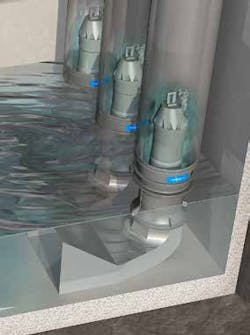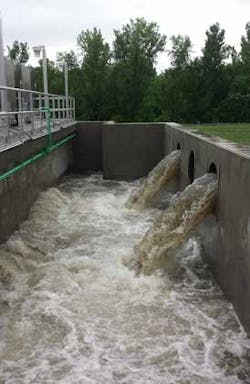The Des Moines Metropolitan Wastewater Reclamation Authority (WRA) protects public health and enhances the environment by recycling wastewater and hauling liquid wastes. The WRA includes a conveyance system, which connects each of the authority’s members to a wastewater treatment plant.
During the large storm events in the past, combined sewer overflow would be discharged to the Des Moines River— untreated.
Scope
In 2008 the WRA retained consulting engineer HDR to provide planning, permitting, design, construction, and start-up services for a high-rate CSO treatment facility called the Combined Sewer Solids Separation Facility or CSSSF. The goal was to store and/or treat CSO flows during wet weather. The facility was to be capable to reduce the adverse impacts of wet weather flows to the existing nearby wastewater reclamation facility.
HDR, working in conjunction with Electric Pump, Inc., the local Flygt representative, and with technical assistance from Xylem-Flygt, evaluated several preliminary sump design concepts. The result was an innovative two-stage wet well and sump design concept incorporating a low-flow sump and high-flow pump wet well. The high-flow pump arrangement incorporated new Formed Suction Intakes (FSI) that reduced the size of the wetwell.
Solutions
Flygt engineers evaluated the original design concept and recommended converting the two side-by-side pump stations into a single sump design concept. This design not only brought both stations together by using standard sump design concepts for the centrifugal pumps and the axial flow pumps, but also included FSIs for each of the axial flow pumps to provide an additional reduction in the overall width of the pump station.
Three centrifugal low-flow pumps—CP-3501, 325-hp submersibles—were sized to provide 90 mgd with all three in service. Submersible and raw water C-pumps operate directly in the liquid being pumped, which means they require neither special housing nor a superstructure to support them, considerably reducing construction costs. Six PL-7121, 525-hp axial flow submersible pumps, with a capacity of 300 mgd in the high flow side of the pump station, were selected to provide the remainder of the 390 mgd of pumping capacity. Submersible PL pumps are compact motor and pump units that require no separate lubrication system or an external cooling system.
The FSI concept resulted in a smaller channel width while also removing separation walls between adjacent pump tubes, enabling a smaller overall wet well. The unique two-stage wet well provided many advantages: it minimized the wet well footprint, reduced construction costs, and also lowered projected operation and maintenance costs and post event cleaning efforts.
Results
The CSSSF was put into service on August 31, 2014 to pump CSO flow from two large rain events. The pump station pumped 90 mgd for over three hours and worked as designed with no issue. The CSSSF captured and treated eight million gallons of combined sewer wastewater that would have otherwise been discharged to the Des Moines River untreated. Since that initial storm, the CSSSF has successfully operated during several large storm events, including an extremely large event on June 24, 2015 where over 390 mgd of combined sewer flow were pumped and discharged to the river. This event lasted over six hours with no significant issues.
Flygt innovative improvements with a formed suction intake resulted in a smaller station footprint and saved Des Moines MWRA $1.2 million in construction costs.
Editor's Note: Scranton Gillette Communications and the SGC Water Group are not liable for the accuracy, efficacy and validity of the claims made in this piece. The views expressed in this content do not reflect the position of the editorial teams of Water & Wastes Digest, Water Quality Products and Storm Water Solutions.

